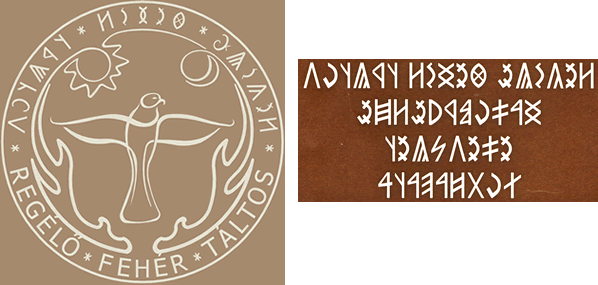Notable features
- Type of writing system: alphabet.
- Usually written on sticks in boustrophedon style (alternating direction right to left then left to right), although the right to left direction was most common.
- There are separate letters for all the phonemes of Hungarian and are in this respect better suited to written Hungarian than the Latin alphabet.
- Words were separated by three vertical dots.
- Ligatures were often used and sometimes an entire word was written with a single sign.
- There are no lower or upper case letters, but the first letter of a proper name was often written a bit larger.
- Vowels were sometimes not written, unless their omission would cause ambiguity.
- The consonants with (a) next to them were used before a, á, o, ó, u and ú, while those with (e) next to them were used before e, ë, é, i, í, ö, ő, ü, ű
- A number of separate symbols, known as capita dictionum or the head of the words, were also used, though their usage is uncertain.
Used to write
Hungarian (Magyar), a Uralic language with about 15 million speakers in Hungary, Romania, Serbia, Ukraine and Slovakia. There are also many people of Hungarian origin in the UK and other European countries, the USA, Canada and Australia.Székely-Hungarian Rovás

Numerals

Sample texts

Translation into Modern Hungarian
(Ezt) az Úr születése utáni 1501. évben írták. Mátyás, János, István kovácsok csinálták. Mátyás mester (és) Gergely mester csinálták [uninterpretable].English translation
(This) was written in the 1501st year of our Lord. The smiths Matthias, John (and) Stephen did (this). Master Matthias (and) Master Gergely did [uninterpretable]Source: http://en.wikipedia.org/wiki/Old_Hungarian_script

Translation
Feher Taltos Traditional Hungarian Drummers (Regélő Fehér Táltos)Links
Information about Székely-Hungarian Rováshttp://en.wikipedia.org/wiki/Old_Hungarian_script
http://wiki.rovas.info
http://www.solyommadar.hu
http://books.google.com/books?id=TyK8azCqC34C&pg=PA177&hl=hu&source=gbs_toc_r&cad=3#v=onepage&q&f=false







.jpg)




.jpg)
.jpg)





0 comments:
Post a Comment
Note: Only a member of this blog may post a comment.